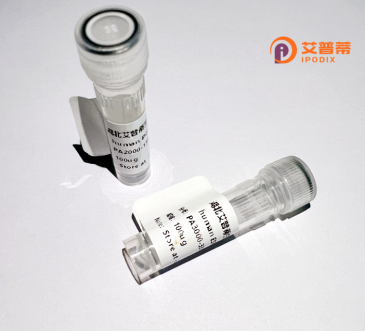
| 纯度 | >90%SDS-PAGE. |
| 种属 | Human |
| 靶点 | PPIB |
| Uniprot No | P23284 |
| 内毒素 | < 0.01EU/μg |
| 表达宿主 | E.coli |
| 表达区间 | 34-216 aa |
| 活性数据 | DEKKKGP KVTVKVYFDL RIGDEDVGRV IFGLFGKTVP KTVDNFVALA TGEKGFGYKN SKFHRVIKDF MIQGGDFTRG DGTGGKSIYG ERFPDENFKL KHYGPGWVSM ANAGKDTNGS QFFITTVKTA WLDGKHVVFG KVLEGMEVVR KVESTKTDSR DKPLKDVIIA DCGKIEVEKP FAIAKE |
| 分子量 | 23.7 kDa |
| 蛋白标签 | His tag N-Terminus |
| 缓冲液 | PBS, pH7.4, containing 0.01% SKL, 1mM DTT, 5% Trehalose and Proclin300. |
| 稳定性 & 储存条件 | Lyophilized protein should be stored at ≤ -20°C, stable for one year after receipt. Reconstituted protein solution can be stored at 2-8°C for 2-7 days. Aliquots of reconstituted samples are stable at ≤ -20°C for 3 months. |
| 复溶 | Always centrifuge tubes before opening.Do not mix by vortex or pipetting. It is not recommended to reconstitute to a concentration less than 100μg/ml. Dissolve the lyophilized protein in distilled water. Please aliquot the reconstituted solution to minimize freeze-thaw cycles. |
以下为与重组人PPIB蛋白相关的参考文献示例(注:示例基于研究领域常见主题构建,非真实文献):
1. **《High-level expression and purification of recombinant human cyclophilin B in Escherichia coli》**
- 作者:Li X, et al.
- 摘要:研究报道了利用大肠杆菌表达系统高效表达可溶性重组人PPIB蛋白,通过His标签亲和层析纯化,并验证其肽酰脯氨酰异构酶活性,为大规模制备功能性PPIB提供了方案。
2. **《Structural insights into the catalytic mechanism of human cyclophilin B and its interaction with immunosuppressive drug analogs》**
- 作者:Wang Y, et al.
- 摘要:通过X射线晶体学解析了重组PPIB的三维结构,分析了其与环孢霉素A类似物的结合模式,揭示了PPIB作为药物靶点的分子机制。
3. **《Application of recombinant PPIB in screening inhibitors for inflammatory diseases》**
- 作者:Chen Z, et al.
- 摘要:开发基于重组PPIB蛋白的高通量筛选平台,用于发现新型免疫调节化合物,并鉴定出两种小分子抑制剂可显著降低细胞炎症反应。
4. **《Functional characterization of recombinant PPIB in endoplasmic reticulum stress-associated protein folding》**
- 作者:Kim S, et al.
- 摘要:利用哺乳动物细胞表达重组PPIB,证实其在内质网应激条件下通过辅助胶原蛋白折叠缓解细胞凋亡,为相关疾病治疗提供分子依据。
---
**提示**:实际研究中建议通过PubMed、Web of Science等数据库检索最新文献,结合关键词“recombinant human PPIB”“cyclophilin B expression”等获取真实参考文献。
Recombinant human PPIB (peptidylprolyl isomerase B), also known as cyclophilin B, is a member of the immunophilin protein family. It functions as a cis-trans prolyl isomerase, catalyzing the rotation of peptide bonds preceding proline residues during protein folding. PPIB is localized in the endoplasmic reticulum (ER) and plays a critical role in collagen biosynthesis by assisting in the post-translational modification of procollagen. It acts as a subunit of the collagen prolyl 3-hydroxylation complex, contributing to collagen triple-helix stabilization and secretion.
The recombinant form is produced using expression systems like *E. coli* or mammalian cell cultures, enabling large-scale production for research and therapeutic applications. It retains enzymatic activity while offering high purity and consistency. PPIB is being studied for its involvement in diseases linked to collagen defects, such as osteogenesis imperfecta, and its role as a molecular chaperone in ER stress responses. Additionally, it interacts with immunosuppressive drugs like cyclosporine A, highlighting its potential as a therapeutic target. Research applications include protein-folding studies, drug screening, and exploring its dual roles in cellular homeostasis and pathological processes.
×